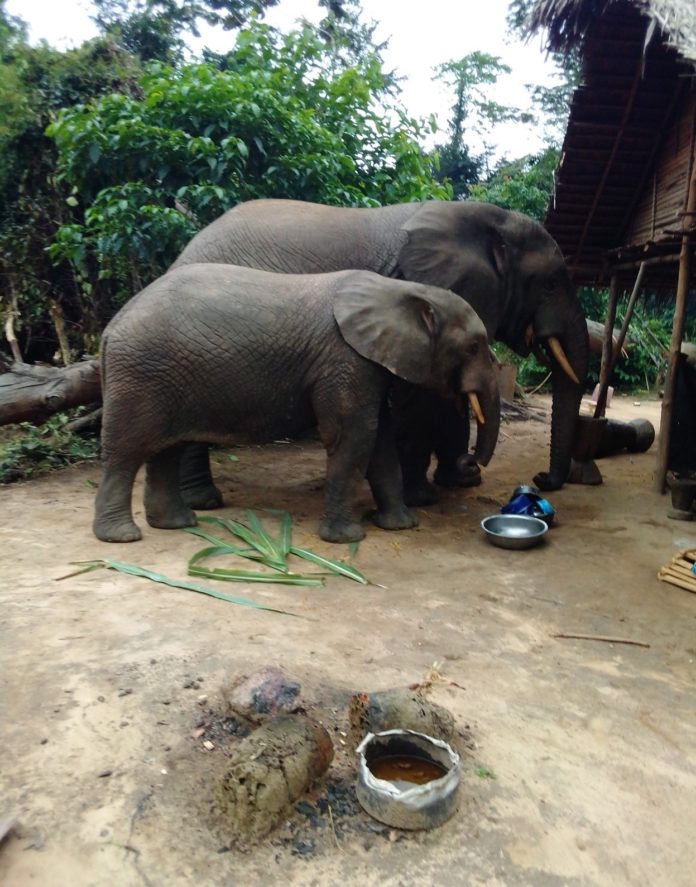
In March 2021 the International Union for the Conservation of Nature (IUCN) published the breaking news that the African Forest Elephant is now considered as a separate species and Critically Endangered, the highest class for risk of extinction. So each individual counts!
Following nearly three years of concentrated study in the north western forest block of Liberia, the Elephant Research and Conservation (ELRECO) which forms part of FDA’s conservation partners with specialty in elephant study has primarily made public its findings.
The exercise, funded by the Born Free Foundation and Elephant Crisis Fund commenced in December 2018 in the Northwestern Forest Block and was completed by January 2021.
It included Interview surveys conducted in 19 communities, and rapid field assessments carried out in 28 different forest sites. The results show that elephants are widely distributed across the entire landscape thereby making the area feasible for elephant conservation in Liberia, especially the Protected/Proposed Protected Areas including the Foya-Gola belt which has been identified as a high priority area for long-term conservation efforts, as well as a suitable site for monitoring and research.
According to the report, since elephants migrate and do also occur outside (P)PAs, it will be crucial to maintain the connectivity between all the identified key sites where signs of Forest Elephants were found in all type of habitats, including Primary/Old Secondary Forest, Young Secondary Forest, Post-cultural Secondary Forest, Swamps, Clearings, Riverine Forest and cultivated areas, at elevations ranging from 110 to 1049 meters above sea level.
The study further revealed that the Forest Elephant population of the NW Forest Block is intact and reproducing. Age and size class distribution correspond to the natural population structure of a long-living and slow-reproducing species. From research conducted it is assumed that there are seven subpopulations roaming in the Northwestern Forest Block, with a total population estimate of 350-450 elephants.
This preliminary conservative estimate reflects a very low number of elephants compared to the potentially available forest area, and demonstrates how vulnerable the species is to any harm and how many elephants must have been lost during the past decades.
The analysis of migration patterns indicates that elephants spread out more and come closer to human settlements in the rainy season, while in the dry season they seem to stay deeper inside the forest. Driving factors are spatial and seasonal availability of water and food resources, combined with a natural tendency to avoid humans.
Human -animal Conflict
The report took into account the major direct threats to Forest Elephants in the NW Forest Block including human encroachment and disturbance of elephant habitats, and the resulting Human-Elephant-Conflicts (HEC), which is a dominating topic in the overall perception of elephants among local people which calls for thorough investigation.
The report says a lot of communities complained from Human-Elephant-Conflict (HEC), mostly crop-raiding.
According to the research a total of twelve HEC hotspots, i.e. main conflict areas comprising several communities were identified in the NW and recorded only three areas where minor issues existed.
The HEC assessment further showed that affected communities do not have much knowledge of suitable conflict mitigation methods, and usually people stay passive, run away from their farms or even give up farming.
Hence, since no active farm guarding is practiced in any of the hotspots a lot of anger and frustration often exist among local people, leading to a very negative attitude towards elephants and elephant conservation, sometimes to such an extent that people threaten to kill the crop-raiding elephants.
The report recommends a speedy redress of the situation and mitigation, starting with a training of affected communities in suitable, community-based, i.e. cheap, simple and instantly applicable mitigation methods.
It is recommended that on a medium and long-term perspective, a set of further well-established mitigation measures needs to be introduced and tested for effectiveness in the different HEC sites, and a training ground and HEC mitigation demonstration site shall be established.
“Killing of elephants, which was identified as a third main serious threat to the Forest Elephant in NW Liberia, is not only an issue in the context of HEC, but elephants are still poached and killed for ivory. At least 18 elephants have been killed in Liberia since October 2018, ten in the Northwestern and 8 in the Southeastern Forest Block, and those are just the known cases.
Although usually action is taken by the responsible government authorities, results are still poor and not satisfying. This threat has to be urgently eliminated by appropriate measures such as effective law enforcement, consolidation of regular, well-equipped ranger patrols and awareness campaigns,” the report furthered.
Meanwhile Liberia Forestry Development Authority Deputy Managing Director for Operations Joseph J. Tally has lauded the ELRECO team for the job well done and described the report as vital tool in the conservation of elephants in Liberia. He pledged FDA’s cooperation and continued collaboration with the team to ensure effective conservation of elephants and other wildlife species in Liberia.
In 2017, the Government of Liberia endorsed the Liberia National Action Plan (NEAP), a 10-year strategy for the protection and sustainable conservation of the Forest Elephant (Loxodonta cyclotis) in Liberia and transboundary areas. In 2018, Elephant Research and Conservation (ELRECO) together with the Forestry Development Authority Liberia (FDA) started the Forest Elephant Conservation Project Liberia, a long-term project that focuses on the implementation of priority actions set out in the NEAP.
One priority under NEAP Objective 5 “Strengthen knowledge of elephant status and management” is to conduct a nationwide elephant status survey in Liberia’s two remaining forest blocks, i.e. in the Northwest and the Southeast of the country, in order to provide a consolidated database about the species’ occurrence, spatial and seasonal distribution, population densities, threats, areas of Human-Elephant Conflicts, ivory trade and identify critical habitats and key populations for long-term elephant monitoring and research programmes.
Since the Northwest had been more neglected in terms of general conservation activities in the past, and according to FDA more HEC cases are reported from that area than from the Southeast , the Forest Elephant Conservation Project started the status survey in the NW Forest Block, which meanwhile has been completed.
Their report presents the results of the Forest Elephant status in the Northwestern Forest Block of Liberia.
Shelton Gonkerwon contributed this story






















Comments are closed.